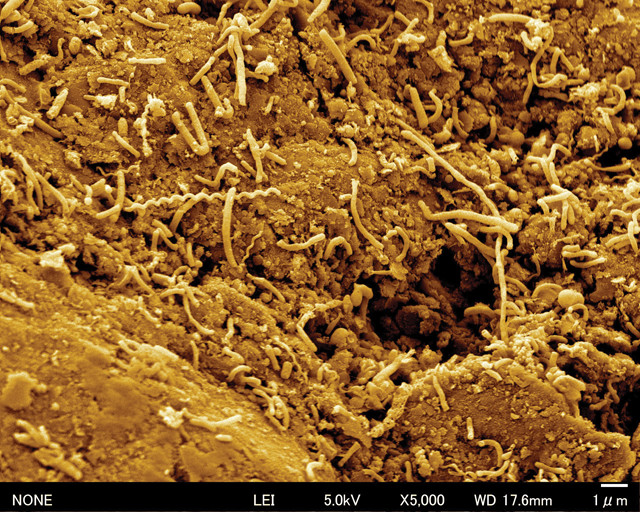
by Timothy Oleson Tuesday, December 15, 2015

Microbes cultured from a coal seam buried 2 kilometers below the seafloor off Japan are seen in this scanning electron microscope image at 5,000-times magnification. Credit: Hiroyuki Imachi, JAMSTEC.
Scientists studying sediments collected from the deepest scientific borehole ever drilled have found microorganisms living at astounding depths beneath the seafloor. Recent studies have previously found bacteria and archaea scratching out meager livings in marine sediments buried as deep as 1.9 kilometers, but the new find extends the known biosphere even farther down.
In Science, Fumio Inagaki of the Japan Agency for Marine-Earth Science and Technology and colleagues reported microbial concentrations as high as about 10,000 cells per cubic centimeter in sediments pulled from between 1.5 and 2.5 kilometers below the seafloor off the coast of Japan. These terrestrial sediments were initially deposited in a coastal wetland setting, which subsided and was eventually buried offshore by marine sediments for 20 million years. Over that time, organic matter in the wetland sediments was converted into layers of lignite coal, which is where Inagaki’s team found the highest numbers of cells living off hydrogen and carbon from the coal.
Based on RNA analyses, the researchers found that the deep microorganisms they identified resemble microbes that inhabit forest soils more so than marine species, suggesting that the current inhabitants might descend from terrestrial microbes buried along with the wetland sediments. Isotopic and biomarker evidence also suggested the microbes were producing methane.
“The ramifications of a massive buried biosphere are important on a global scale, with subseafloor microbes playing a crucial role in carbon sequestration, element cycles, and Earth’s evolution,” wrote Julie Huber of the Marine Biological Laboratory in Woods Hole, Mass., in a commentary about the new study also published in Science. The new report “marks the deepest detection of active life to date,” she noted.
© 2008-2021. All rights reserved. Any copying, redistribution or retransmission of any of the contents of this service without the expressed written permission of the American Geosciences Institute is expressly prohibited. Click here for all copyright requests.